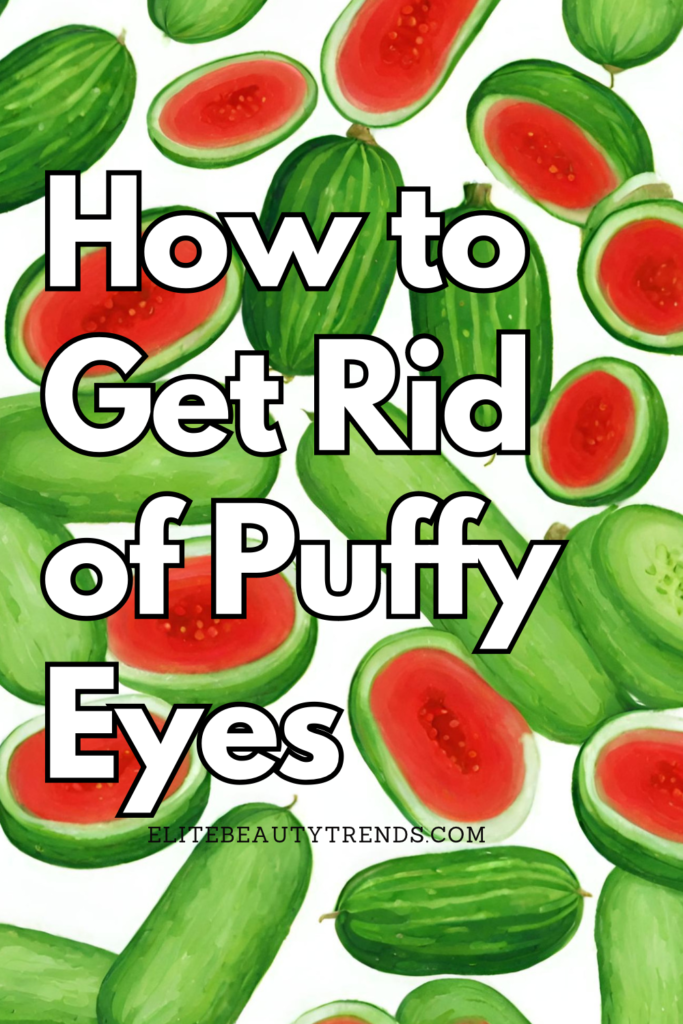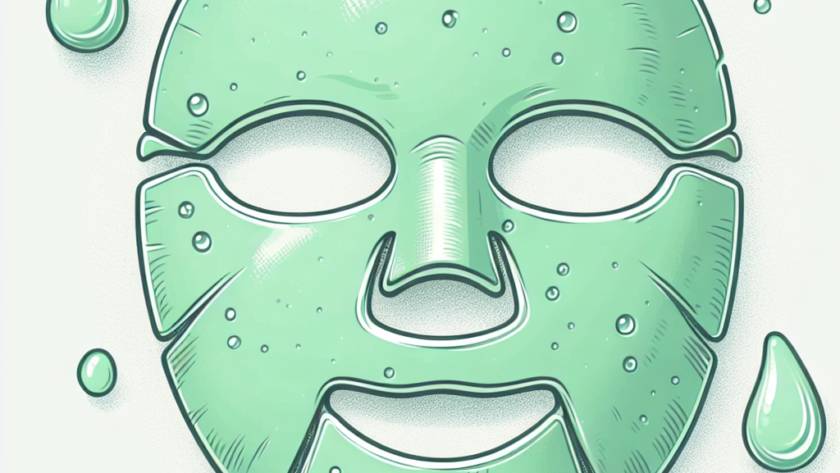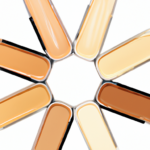Are you ready to know how to get rid of puffy eyes?
Are you tired of waking up in the morning with puffy eyes that make you look like you just had a good cry? Don’t fret, because in this article, we will explore some simple yet effective tips on reducing under-eye puffiness. Whether it’s caused by lack of sleep, allergies, or simply genetics, we’ve got you covered with techniques that will have you saying goodbye to those pesky bags under your eyes. So grab a cup of tea, sit back, and let’s discover how you can achieve a refreshed and revitalized look.
Causes of Under-eye Puffiness
Fluid retention
One of the common causes of under-eye puffiness is fluid retention. When excess fluid accumulates in the tissues around the eyes, it can lead to swelling and puffiness. This can be caused by various factors such as hormonal changes, high salt intake, or even certain medications. To reduce fluid retention, it is important to maintain a balanced diet, limit salt intake, and drink plenty of water to help flush out toxins and excess fluids from the body.
- Neutrogena Hydro Boost Eye Gel-Cream: A great solution for hydration and reducing fluid retention-related puffiness
Fatigue and lack of sleep
Lack of sleep and fatigue are notorious culprits when it comes to under-eye puffiness. When you don’t get enough restorative sleep or experience chronic fatigue, it can cause blood vessels to dilate and fluid to accumulate under the eyes. Making sure you get enough quality sleep each night and incorporating relaxation techniques into your routine can help reduce under-eye puffiness.
- Olay Eyes Ultimate Eye Cream: Addresses puffiness due to fatigue with its rejuvenating formula.
Aging
As we age, the skin around our eyes becomes thinner and loses elasticity, making it more prone to puffiness. This is due to a combination of factors, including decreased collagen production and weakening of the muscles supporting the under-eye area. While aging is a natural process, there are lifestyle changes and treatments that can help minimize under-eye puffiness and maintain a youthful appearance.
- La Roche-Posay Pigmentclar Eyes: Helps with aging-related puffiness and dark circles.
Allergies
Allergies, whether seasonal or due to specific triggers, can cause under-eye puffiness in some individuals. Allergic reactions release histamines, which can cause blood vessels to dilate and lead to swelling around the eyes. Identifying and avoiding allergens, managing allergies with medications or natural remedies, and keeping the under-eye area clean can help reduce puffiness caused by allergies.
Genetics
Unfortunately, genetics play a role in the development of under-eye puffiness. If your parents or close family members have a tendency to develop puffy under-eye bags, there is a higher likelihood that you may also experience the same issue. While you cannot change your genetics, adopting a healthy lifestyle and using targeted treatments can help minimize the appearance of under-eye puffiness.

Poor diet and hydration
A poor diet and inadequate hydration can contribute to under-eye puffiness. Consuming excessive amounts of salt, alcohol, or processed foods can lead to fluid retention and inflammation, causing the under-eye area to appear puffy. Additionally, not drinking enough water can result in dehydration, making the skin under the eyes appear dull and swollen. Opting for a balanced diet rich in fruits, vegetables, lean proteins, and drinking sufficient water can make a significant difference in reducing under-eye puffiness.
Lifestyle Changes and Home Remedies
- Kiehl’s Creamy Eye Treatment with Avocado: Nourishes and hydrates the under-eye area.
Drink plenty of water
Staying properly hydrated is crucial for overall health and can help reduce under-eye puffiness. Drinking enough water throughout the day helps flush out toxins and excess salt in the body, which can contribute to fluid retention. Aim to drink at least 8 glasses of water daily and increase your intake if you are physically active or live in a hot climate.
Get enough sleep
Getting sufficient sleep is essential not only for overall well-being but also for reducing under-eye puffiness. When you are sleep-deprived, blood vessels under the eyes can dilate, causing fluid to accumulate and resulting in puffiness. Make it a priority to get 7-9 hours of quality sleep each night and establish a relaxing bedtime routine to ensure a restful night’s sleep.
Elevate your head while sleeping
Elevating your head while sleeping can help prevent fluid accumulation and reduce under-eye puffiness. By propping up a few pillows or using a wedge pillow, you can ensure that your head is elevated above your heart. This position helps prevent fluid from pooling around the eyes, reducing puffiness in the morning.
Reduce salt intake
Excessive salt intake can lead to water retention, which can contribute to under-eye puffiness. Limiting your consumption of salty foods, processed snacks, and high-sodium meals can help reduce fluid retention and decrease puffiness. Instead, opt for fresh, natural foods and season your meals with herbs and spices for flavor.
Apply cold compresses
Cold compresses can provide immediate relief from under-eye puffiness by constricting blood vessels and reducing inflammation. You can use a cold washcloth, chilled spoons, or even refrigerated gel eye masks to apply gentle pressure to the under-eye area. Leave the compress on for 10-15 minutes to help reduce puffiness.
Use cucumber slices or tea bags
Cucumber slices and tea bags have long been used as natural remedies for under-eye puffiness. Cucumbers contain antioxidants and have a cooling effect on the skin, helping to reduce swelling. Place thinly sliced cucumber rounds on your closed eyelids for 10-15 minutes or use cooled tea bags (preferably green tea or chamomile) to reduce puffiness and soothe tired eyes.
Avoid rubbing or touching the under-eye area
Rubbing or touching the under-eye area can worsen puffiness, as it can cause irritation and inflammation. Avoiding rubbing your eyes and being gentle when removing makeup can help minimize under-eye puffiness. Instead, use gentle tapping motions with your fingertips to apply skincare products or reduce puffiness.
Use a gentle, hydrating eye cream
Using a hydrating eye cream can help reduce under-eye puffiness by improving skin hydration and elasticity. Look for an eye cream that contains ingredients such as hyaluronic acid, peptides, caffeine, or antioxidants, as these can help decrease puffiness and promote a more youthful appearance. Gently apply the eye cream using your ring finger, starting from the inner corner of the eye and moving outwards.
Try facial exercises
Facial exercises can help strengthen the muscles around the eyes and minimize under-eye puffiness. One simple exercise involves placing your index fingers under your eyebrows and gently lifting your eyebrows while simultaneously closing your eyes. Hold this position for a few seconds, release, and repeat several times. Regular practice of facial exercises can help tone the under-eye area and reduce puffiness.
Manage allergies
If allergies contribute to under-eye puffiness, managing them effectively can help minimize the condition. Consult with an allergist to identify your specific triggers, and take necessary measures to avoid exposure to allergens. This may include using air purifiers, keeping windows closed during peak allergy seasons, and using over-the-counter or prescription allergy medications to alleviate symptoms.
Natural Remedies for Under-eye Puffiness

- Fresh Black Tea Age-Delay Eye Concentrate: A natural antioxidant-rich solution for puffiness.
Aloe vera gel
Aloe vera gel has soothing and anti-inflammatory properties that can help reduce under-eye puffiness. Apply a small amount of pure aloe vera gel to the under-eye area and gently massage it in using your fingertips. Leave it on for 10-15 minutes before rinsing off with cool water. Regular use of aloe vera gel can help reduce puffiness and promote healthier skin.
Cucumber juice or slices
Cucumber juice or slices can be used as a natural remedy for under-eye puffiness due to their hydrating and cooling properties. To extract cucumber juice, blend a cucumber and strain the juice. Dip a cotton pad in the juice and place it over your closed eyelids for 10-15 minutes. Alternatively, you can place cucumber slices directly on your eyelids for similar effects.
Potato slices or juice
Potatoes have natural astringent properties that can help reduce under-eye puffiness. Slice a cold raw potato into thin rounds and place them on your closed eyelids for 10-15 minutes. Alternatively, you can extract potato juice and apply it to the under-eye area using a cotton pad. This remedy can help reduce puffiness and brighten the skin.
Chamomile tea bags
Chamomile tea bags can be used as a natural remedy to reduce under-eye puffiness and soothe tired eyes. Steep two chamomile tea bags in hot water, then allow them to cool in the refrigerator for 30 minutes. Place the chilled tea bags on your closed eyelids for 10-15 minutes. The anti-inflammatory properties of chamomile can help alleviate puffiness and provide a refreshing sensation.

Cold milk compress
Cold milk compresses can help reduce under-eye puffiness and brighten the skin. Soak cotton pads in cold milk and place them on your closed eyelids for 10-15 minutes. The lactic acid present in milk helps to depuff the under-eye area, while the cold temperature promotes vasoconstriction, reducing swelling.
Tea tree oil
Tea tree oil has anti-inflammatory properties that can help reduce under-eye puffiness caused by irritation or allergies. Mix a few drops of tea tree oil with a carrier oil, such as coconut oil or almond oil, and gently massage the mixture onto the under-eye area. Leave it on for 10-15 minutes before rinsing off with cool water. Be cautious when using tea tree oil and perform a patch test to ensure you are not sensitive to it.
Rosewater
Rosewater has soothing and anti-inflammatory properties that can help reduce under-eye puffiness. Soak cotton pads in chilled rosewater and place them on your closed eyelids for 10-15 minutes. The natural astringent properties of rosewater can help tighten and depuff the under-eye area, leaving your eyes looking refreshed.
Coconut oil
Coconut oil can help moisturize and nourish the under-eye area, reducing puffiness and promoting healthier skin. Gently massage a small amount of coconut oil onto the under-eye area using your fingertips. Leave it on overnight and rinse off in the morning. Regular use of coconut oil can help minimize under-eye puffiness and provide a natural glow.
Green tea bags
Green tea bags can be used as a natural remedy for under-eye puffiness due to their antioxidant and anti-inflammatory properties. Steep two green tea bags in hot water, then allow them to cool in the refrigerator for 30 minutes. Place the chilled tea bags on your closed eyelids for 10-15 minutes and enjoy the soothing effects of green tea on your under-eye area.
Witch hazel
Witch hazel has astringent properties that can help reduce under-eye puffiness and tighten the skin. Soak cotton pads in witch hazel and place them on your closed eyelids for 10-15 minutes. The cooling and soothing effects of witch hazel can help alleviate puffiness and refresh the under-eye area.
Over-the-Counter Products and Treatments
Under-eye creams and serums
Under-eye creams and serums specifically formulated to target puffiness can be effective in reducing under-eye puffiness. Look for products containing ingredients such as caffeine, hyaluronic acid, vitamin K, or peptides, as these can help improve circulation, promote hydration, and reduce inflammation. Follow the instructions provided with the product and incorporate it into your skincare routine for optimal results.
Rollerball or massaging tools
Rollerball or massaging tools can be used in combination with eye creams to help reduce under-eye puffiness. The rolling motion of the tool helps improve lymphatic drainage and reduce fluid buildup around the eyes. Gently glide the rollerball or massaging tool outward from the inner corner of the eye to the temples, applying gentle pressure. This can help stimulate circulation and reduce puffiness.

Caffeine-based products
Caffeine has vasoconstrictive properties, making it an effective ingredient in reducing under-eye puffiness. Look for eye creams, serums, or gels containing caffeine, and apply them to the under-eye area in the morning or as needed. The caffeine helps constrict blood vessels, reducing puffiness and giving a more refreshed appearance.
Topical treatments with vitamin C or retinol
Topical treatments containing vitamin C or retinol can help improve the appearance of under-eye puffiness. Vitamin C promotes collagen production and brightens the skin, while retinol helps improve skin texture and firmness. Apply a small amount of product to the under-eye area, avoiding direct contact with the eyes, and follow the instructions provided with the product for best results.
Cold roller devices
Cold roller devices, such as jade or metal rollers, can be used to reduce under-eye puffiness. Place the roller device in the refrigerator for a few minutes to cool it down, then gently roll it over the under-eye area, moving from the inner corner to the temples. The cold temperature and gentle massage can help stimulate lymphatic drainage and reduce puffiness.
Eye masks and patches
Eye masks and patches infused with soothing and hydrating ingredients can provide immediate relief from under-eye puffiness. Choose masks or patches that contain ingredients like hyaluronic acid, collagen, or antioxidants. Apply them to clean skin and leave them on for the recommended time. The cooling and nourishing properties of the masks or patches can help reduce puffiness and revitalize the under-eye area.

Hyaluronic acid-based products
Hyaluronic acid is a hydrating ingredient that can help plump and moisturize the under-eye area, reducing the appearance of puffiness. Look for eye creams or serums that contain hyaluronic acid and apply them to the under-eye area as part of your skincare routine. The hyaluronic acid will help restore moisture to the skin and improve its overall appearance.
Antihistamine eye drops
If under-eye puffiness is caused by allergies, over-the-counter antihistamine eye drops may provide relief. Consult with a healthcare professional or pharmacist to identify the best antihistamine eye drops for your specific needs. Follow the instructions provided with the product to effectively alleviate allergy-related puffiness.
Skin firming and tightening creams
Skin firming and tightening creams can help reduce under-eye puffiness by improving elasticity and promoting a firmer appearance. Look for products that contain ingredients such as peptides, collagen, or retinol, as these can help tighten the skin and reduce puffiness over time. Apply the cream to clean skin and gently massage it into the under-eye area, following the recommended usage guidelines.
Medical Procedures and Professional Treatments
Fillers or injectables
Dermal fillers or injectables can be used to address under-eye puffiness caused by loss of volume or fat. A skilled medical professional can carefully inject fillers into the under-eye area to create a smoother and more youthful appearance. This can help greatly reduce the appearance of under-eye puffiness and provide long-lasting results.
Blepharoplasty or eyelid surgery
Blepharoplasty, also known as eyelid surgery, can be a more invasive option for reducing under-eye puffiness. During this procedure, excess skin and fat are removed from the eyelid area, helping to eliminate puffiness and improve the overall appearance. Eyelid surgery is typically performed by a qualified plastic surgeon and requires a recovery period.
Laser resurfacing
Laser resurfacing can be an effective treatment for reducing under-eye puffiness caused by skin laxity and wrinkles. The procedure uses laser technology to stimulate collagen production and tighten the skin. Laser resurfacing can help improve the appearance of under-eye puffiness and provide a more youthful and rejuvenated look.
Chemical peels
Chemical peels can help reduce under-eye puffiness by removing the outermost layers of skin and promoting cell turnover. This procedure involves applying a chemical solution to the skin, which causes it to peel and reveal fresher, smoother skin underneath. Chemical peels can help minimize under-eye puffiness and improve skin texture and tone.
Radiofrequency treatments
Radiofrequency treatments use energy waves to heat the deeper layers of the skin and stimulate collagen production. This can help tighten and firm the under-eye area, reducing puffiness and improving the overall appearance. Radiofrequency treatments are typically performed by qualified professionals and can provide long-lasting results with minimal downtime.
Micro-needling
Micro-needling, also known as collagen induction therapy, involves using tiny needles to create controlled micro-injuries in the skin. This triggers the body’s natural healing response, stimulating collagen production and reducing under-eye puffiness. Micro-needling treatments can be performed by dermatologists or qualified estheticians and can help improve the texture and tone of the skin.
Lymphatic drainage massage
Lymphatic drainage massage is a specialized technique that helps improve lymphatic circulation and reduce fluid retention. This can be beneficial for individuals experiencing under-eye puffiness caused by fluid buildup. A trained massage therapist can perform lymphatic drainage massage on the face and under-eye area, helping to alleviate puffiness and promote overall well-being.
Under-eye fat removal surgery
Under-eye fat removal surgery, also known as lower blepharoplasty, involves removing excess fat deposits from the lower eyelid area. This can help reduce under-eye puffiness caused by fat bulges and improve the overall appearance of the eyes. Under-eye fat removal surgery is typically performed by a qualified plastic surgeon and requires a recovery period.
Platelet-rich plasma (PRP) therapy
Platelet-rich plasma (PRP) therapy involves using a person’s own blood to extract plasma rich in platelets and growth factors. This plasma is then injected into the under-eye area to stimulate collagen production and improve the appearance of puffiness. PRP therapy is a natural and non-surgical option that can provide long-lasting results.
Cryotherapy
Cryotherapy, also known as cold therapy, involves exposing the skin to extremely cold temperatures to stimulate circulation and decrease inflammation. This can be beneficial in reducing under-eye puffiness. Cryotherapy treatments can be performed by trained professionals using specialized equipment or through at-home methods such as cold packs or ice rollers.
Preventive Measures for Under-eye Puffiness
Maintain a healthy lifestyle
Maintaining a healthy lifestyle can help prevent under-eye puffiness. This includes following a balanced diet, regular exercise, and avoiding excessive alcohol and tobacco consumption. A healthy lifestyle promotes overall well-being and can reduce the risk of developing under-eye puffiness.
- Drunk Elephant C-Tango Multivitamin Eye Cream: Complements a healthy skin care routine.
Get sufficient sleep
Ensuring you get sufficient sleep is essential for preventing under-eye puffiness. Aim for 7-9 hours of quality sleep each night to allow your body to repair and rejuvenate. Establishing a consistent sleep schedule and practicing good sleep hygiene can help promote restful sleep and minimize the risk of developing puffiness.
- Lancôme Advanced Génifique Yeux Eye Cream: Aids in rejuvenating the eye area overnight.

Manage stress levels
High levels of stress can contribute to under-eye puffiness. Finding healthy outlets to manage stress, such as exercise, meditation, or engaging in hobbies, can be beneficial in preventing puffiness. Prioritizing self-care and taking time to relax and unwind can also help reduce stress levels and minimize the appearance of under-eye puffiness.
Protect your under-eye area from sun damage
Excessive sun exposure can lead to premature aging and skin damage, including under-eye puffiness. Protect your under-eye area by wearing sunglasses that provide UV protection and applying sunscreen with at least SPF 30. This can help prevent the breakdown of collagen and elastin, reducing the risk of puffiness.
Avoid rubbing or pulling at the skin
Rubbing or pulling at the delicate skin around the eyes can exacerbate under-eye puffiness. Avoid rubbing your eyes or applying unnecessary pressure when removing makeup or skincare products. Instead, use gentle tapping or patting motions to minimize potential irritation and prevent fluid accumulation.
- Burt’s Bees Sensitive Eye Cream: Ideal for sensitive skin, gently reducing puffiness.
Moisturize regularly
Keeping the under-eye area moisturized can help prevent dryness and reduce the risk of developing puffiness. Use a gentle, hydrating eye cream or serum that is specifically formulated for the delicate eye area. Apply the product using gentle tapping motions, starting from the inner corner of the eye and moving outwards.
Avoid excessive salt and alcohol consumption
Consuming excessive amounts of salt and alcohol can contribute to fluid retention and under-eye puffiness. Limit your intake of salty snacks, processed foods, and alcohol to reduce the risk of fluid accumulation. Opt for fresh, natural foods and drink alcohol in moderation, if at all.
Stay hydrated
Staying hydrated is important for overall health and can help prevent under-eye puffiness. Drink plenty of water throughout the day to keep your body hydrated and promote proper lymphatic circulation. Aim for at least 8 glasses of water a day and increase your intake if you are physically active or live in a hot climate.
Manage allergies and sinus issues
If you have allergies or sinus issues, managing them effectively can help prevent under-eye puffiness. Consult with a healthcare professional to identify your specific triggers and develop an appropriate treatment plan. This may include using over-the-counter or prescription medications, avoiding allergens, or seeking allergy immunotherapy.
Use sunscreen and wear sunglasses
Protecting the delicate skin around the eyes from sun damage is crucial in preventing under-eye puffiness. Apply sunscreen with at least SPF 30 to the under-eye area every day, even if it is cloudy outside. Additionally, wear sunglasses that provide UV protection to shield your eyes from harmful UV rays and minimize the risk of developing puffiness.
When to Seek Medical Attention
Persistent or severe under-eye puffiness
If under-eye puffiness persists or is severe, despite home remedies and lifestyle changes, it may be advisable to seek medical attention. A healthcare professional can evaluate your condition and determine the underlying cause of the puffiness. They may recommend additional treatments or refer you to a specialist for further evaluation.
Accompanying symptoms such as pain or vision changes
If under-eye puffiness is accompanied by pain, vision changes, or other concerning symptoms, it is important to seek medical attention promptly. These symptoms may indicate a more serious underlying condition that requires immediate evaluation and treatment.
Under-eye puffiness after an injury or trauma
If under-eye puffiness occurs after an injury or trauma, it is important to seek medical attention. A healthcare professional can assess the extent of the injury and provide appropriate treatment to prevent further complications. They may also be able to recommend treatments to reduce under-eye puffiness and promote healing.
Under-eye puffiness that does not improve with home remedies or lifestyle changes
If under-eye puffiness does not improve with home remedies, lifestyle changes, or over-the-counter treatments, it may be necessary to consult with a healthcare professional. They can evaluate your condition, identify any underlying causes, and recommend alternative treatments or interventions.
Sudden and unexplained onset of under-eye puffiness
If under-eye puffiness occurs suddenly and without any apparent cause, it is advisable to seek medical attention. Sudden onset of puffiness may indicate an underlying medical condition that requires evaluation and treatment.
Conclusion
Under-eye puffiness can be caused by a variety of factors, including fluid retention, fatigue, aging, allergies, genetics, and poor diet and hydration. However, there are numerous lifestyle changes, home remedies, natural remedies, over-the-counter products and treatments, and medical procedures available to help reduce under-eye puffiness. By implementing preventive measures, managing allergies, and seeking medical attention when necessary, you can successfully minimize under-eye puffiness and maintain a refreshed and youthful appearance. Remember to consult with a healthcare professional or dermatologist for personalized advice and treatment options tailored to your specific needs. With diligence and the right strategies, you can achieve healthier under-eye skin and reduce the appearance of puffiness.





